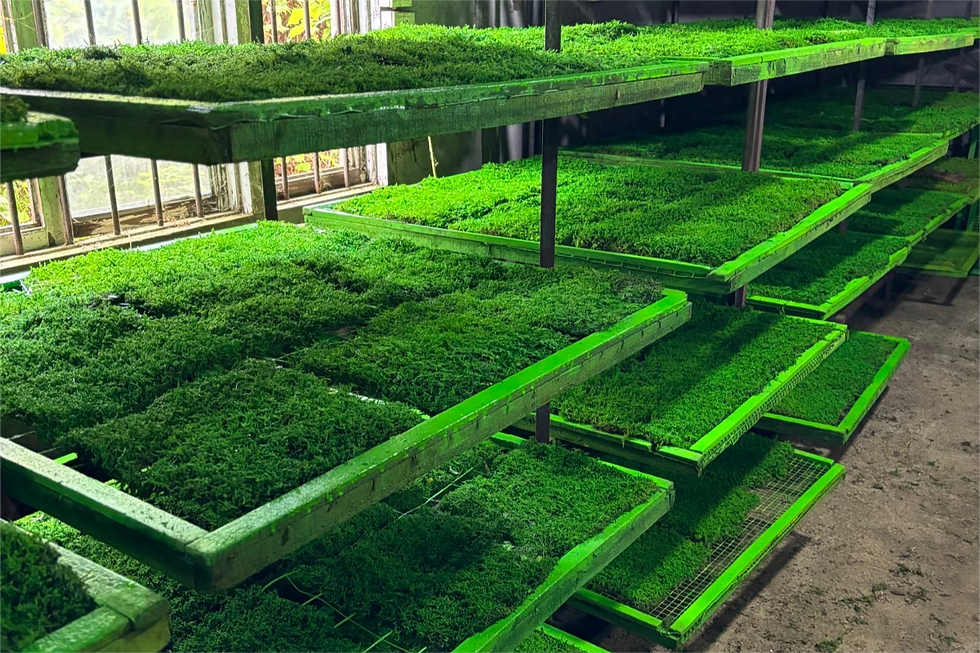How sustainable are preserved flower products?
- Annie Zhang

- Apr 28
- 3 min read
Updated: Jun 10

The floral industry is facing increasing scrutiny over its environmental impact, with fresh flowers demanding vast resources and generating significant waste.
For chain supermarkets and gift brands seeking to meet growing consumer expectations for eco-friendly products, traditional fresh flowers pose a real sustainability challenge.
Preserved flowers offer a smarter, greener alternative—beautiful, long-lasting, and environmentally responsible.
Preserved flowers offer a sustainable alternative to traditional fresh flowers, significantly reducing environmental impact while maintaining natural beauty. By minimizing water use, cutting emissions, and offering long-lasting value, preserved flowers align perfectly with eco-conscious business practices. For chain supermarkets and gift brands seeking environmentally responsible floral solutions, preserved flowers represent a meaningful shift toward sustainability.
Index:
What Are Preserved Flowers?
Preserved flowers are real, natural blooms that have undergone a special preservation process to maintain their fresh appearance and softness for months or even years. Using techniques like dehydration and glycerin-based solutions, the flowers retain their shape, color, and texture without the need for water or sunlight. This innovative method not only enhances the life cycle of the flowers but also dramatically reduces their ecological footprint compared to fresh-cut flowers.
Environmental Benefits of Preserved Flowers over Fresh
Here is a quick comparison between Fresh Flowers and Preserved Flowers:
1. Reduced Water Usage
Fresh flowers require a massive amount of water from cultivation to display. According to the WWF, agriculture accounts for 70% of global freshwater use, with flower farming being a notable contributor (source). Preserved flowers, on the other hand, only require water once during their growth phase and none after preservation. For supermarkets and brands managing large-scale floral programs, choosing preserved flowers can drastically lower water consumption across the supply chain.
2. Reduced Greenhouse Gas Emissions
Traditional fresh flower production often involves greenhouse cultivation, refrigerated transport, and short shelf lives, all of which result in substantial greenhouse gas emissions. In contrast, preserved flowers are processed locally and can be shipped with far less urgency, reducing reliance on energy-intensive cold chain logistics. A study published in "Environmental Science & Technology" highlights that refrigerated transportation significantly amplifies a product's carbon footprint (source).
3. Less Use of Chemicals
Fresh flower farms frequently rely on heavy pesticide and fertilizer use to ensure perfect blooms. These chemicals can leach into soil and waterways, causing long-term environmental damage. The preservation process at Sweetie-Group minimizes chemical use, relying on eco-certified preservation agents that are safe and environmentally friendly. This approach reduces the chemical load associated with traditional floral farming.
4. Less Waste and Longevity
Fresh flowers often have a shelf life of just 7-10 days, leading to a high rate of spoilage and waste. In contrast, preserved flowers can last for 1-3 years with minimal maintenance. For retail brands and supermarkets, this means lower spoilage rates, fewer write-offs, and a more sustainable bottom line. Long-lasting products also mean fewer replacements, aligning with waste-reduction goals.
5. Reuse and Repurpose
One of the hidden strengths of preserved flowers is their versatility. They can be reused in seasonal displays, repurposed for different product lines, or even sold as part of multi-use gift sets. This reusability not only enhances product value but also contributes to a circular economy approach, helping businesses lower their environmental impact and provide customers with meaningful, long-term products.

Why Sweetie-Group Is the Pioneer in Sustainable Floral Solutions
At Sweetie-Group, we take sustainability seriously. Our preservation techniques use eco-friendly, non-toxic chemicals, and we prioritize environmentally responsible sourcing from the very first bloom. We have secured REACH, CE, and phytosanitary certificates to ensure that every product we deliver is safe for people and the planet.
Beyond certifications, our commitment to sustainability is built into our operations. We use recyclable and biodegradable packaging, invest in energy-efficient production facilities, and maintain an active R&D team dedicated to improving our green practices year after year.
As a global leader, with products exported to more than 50 countries and partnerships with brands like Armani Beauty and FamilyMart, we understand the demands and responsibilities of modern retail. Our preserved flowers are not just beautiful; they are a conscious choice for brands seeking to align with growing consumer expectations around sustainability.
If you're ready to explore how Sweetie-Group can help you build a more sustainable floral program, let's connect. Contact us at sales@sweetie-group.com.

Warm Regards,
Annie Zhang
CEO of Sweetie-Group









Comments